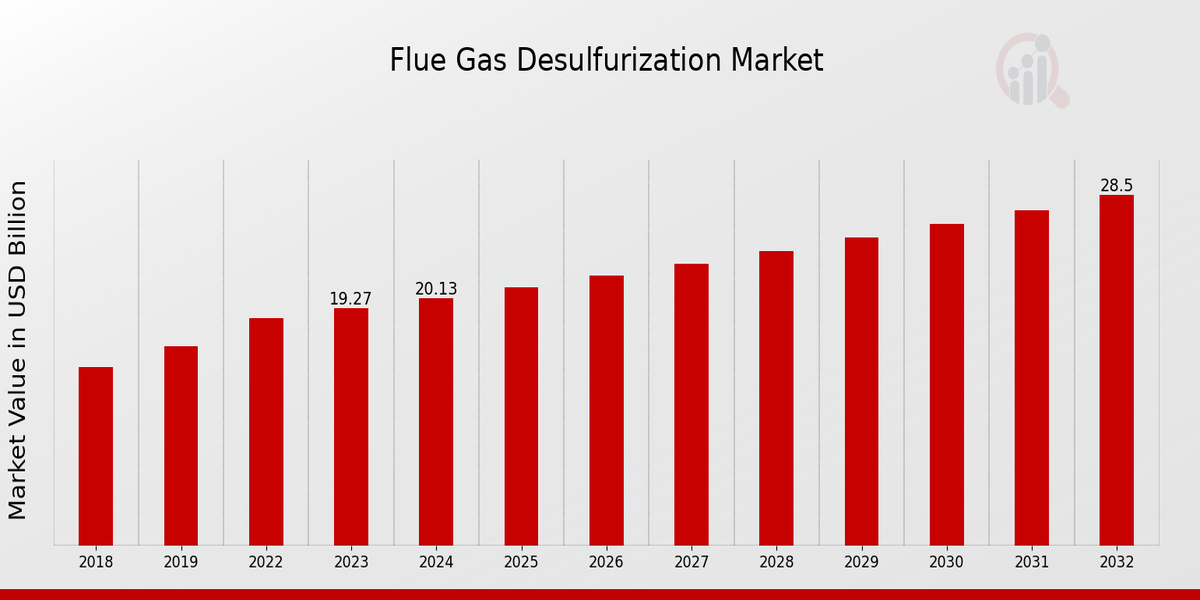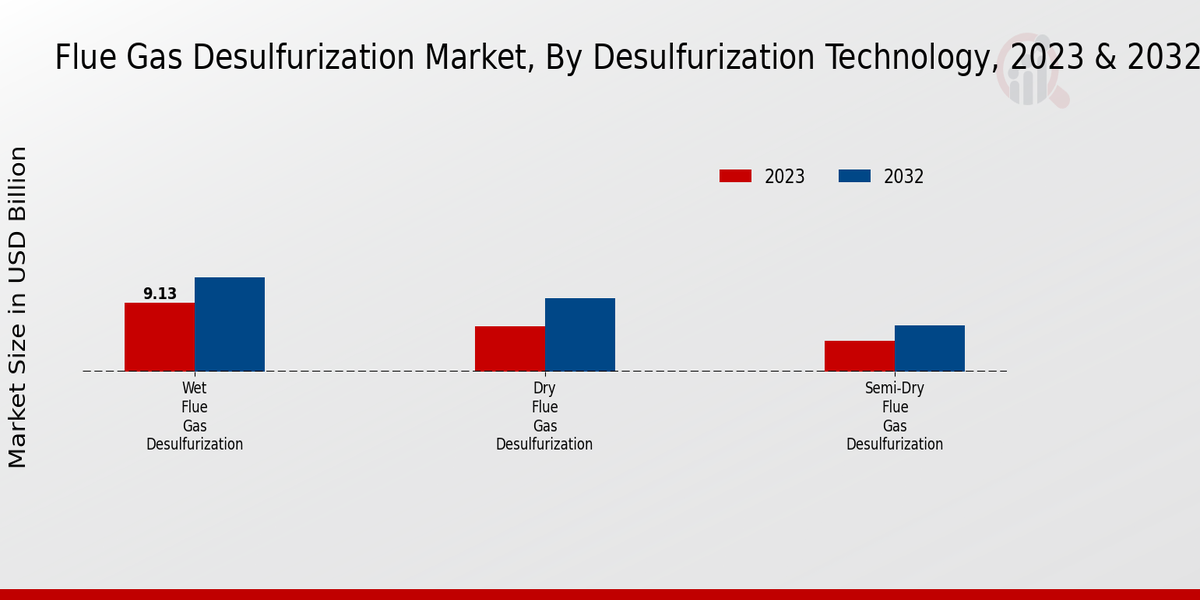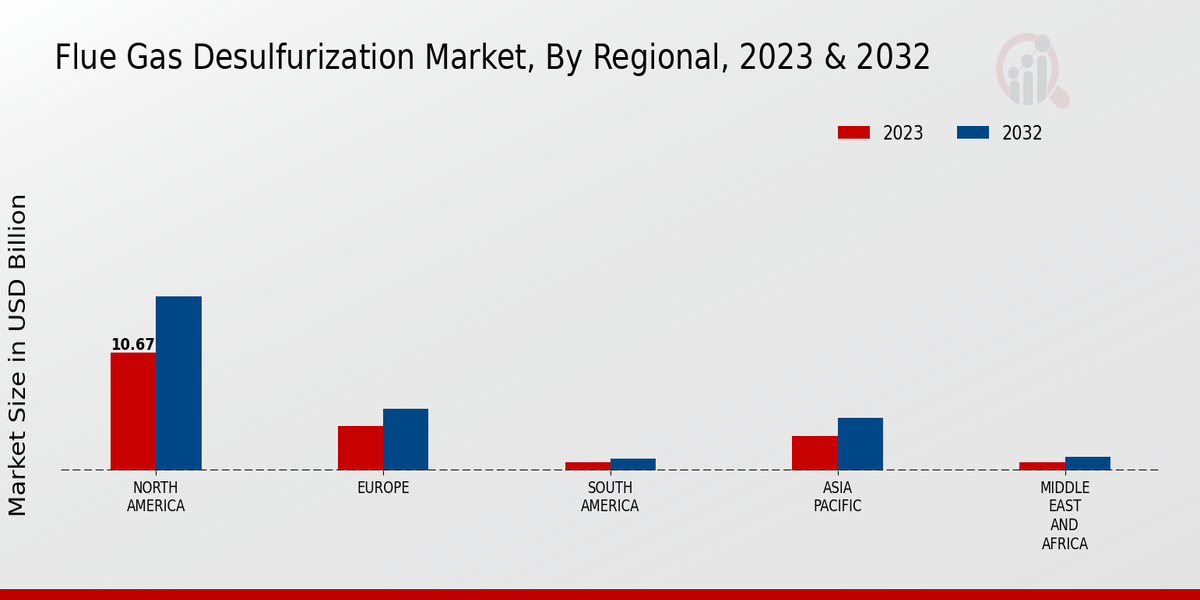Flue Gas Desulfurization Market Overview
Flue Gas Desulfurization Market Size was estimated at 18.46 (USD Billion) in 2022. The Flue Gas Desulfurization Market is expected to grow from 19.27 (USD Billion) in 2023 to 28.5 (USD Billion) by 2032. The Flue Gas Desulfurization Market CAGR (growth rate) is expected to be around 4.44% during the forecast period (2024 - 2032).
Source Primary Research, Secondary Research, MRFR Database and Analyst Review
Key Flue Gas Desulfurization Market Trends Highlighted
The flue gas desulfurization market is characterized by increasing environmental concerns and stringent regulations aimed at reducing sulfur dioxide (SO2) emissions from industrial sources.
Growing awareness of the adverse effects of air pollution on human health and the environment drives the demand for flue gas desulfurization solutions.
Key market drivers include the rising adoption of clean coal technologies, particularly in emerging economies, and the expansion of industries with high SO2 emissions, such as power generation, manufacturing, and mining.
Moreover, government incentives and subsidies for desulfurization systems contribute to market growth. Opportunities lie in the development of advanced technologies for more efficient and cost-effective SO2 removal, catering to the specific needs of various industries.
Recent trends include the shift towards dry desulfurization methods due to their lower water consumption and reduced waste generation.
Additionally, the integration of desulfurization systems with carbon capture and storage technologies is gaining traction as a comprehensive solution for addressing both air pollution and climate change concerns.
Flue Gas Desulfurization Market Drivers
Increasing Stringency of Environmental Regulations
Governments worldwide are implementing stricter environmental regulations to reduce air pollution and protect public health. These regulations mandate the reduction of sulfur dioxide (SO2) emissions from industrial facilities, particularly power plants and manufacturing industries.
Flue gas desulfurization (FGD) systems are essential for achieving compliance with these regulations. By removing SO2 from flue gases, FGD systems help mitigate acid rain, improve air quality, and reduce the incidence of respiratory illnesses.
The increasing stringency of environmental regulations is a key driver for the growth of the Flue Gas Desulfurization Market.
Growing Demand for Coal-Fired Power Plants
In many parts of the world, coal remains to be a major source of electricity generally. With increasing demand for electricity, particularly in the emerging countries, has boosted the establishment of new coal-fired electric plants.
FGD systems are essential in the control of SO2 emissions that are mostly emitted from the coal-powered plants. The need for FGD systems, therefore, will increase as there is an increased demand for coal-fired plants.
Technological Advancements
Technological advances are enhancing efficiency and reducing the cost of FGD systems. Dry scrubbing and semi-dry scrubbing technologies, for example, are preferable in several respects over traditional methods of wet scrubbing.
They reduce water and energy usage, and waste generated in the process. Besides, modern materials and new methods of their production improve the durability of FGD systems.
Consequently, it may be assumed in such a way that technological changes in the Flue Gas Desulfurization Market will be the key drivers of the adoption of FGD systems.
Flue Gas Desulfurization Market Segment Insights
Flue Gas Desulfurization Market Desulfurization Technology Insights
The Flue Gas Desulfurization Market is segmented by desulfurization technology into Wet Flue Gas Desulfurization (WFGD), Dry Flue Gas Desulfurization (DFGD), and Semi-Dry Flue Gas Desulfurization (SDFGD).
Wet Flue Gas Desulfurization (WFGD) was the most mature and widely used desulfurization technology, accounting for over 70% of the Flue Gas Desulfurization Market revenue in 2023.
It involves scrubbing the flue gas with a slurry of limestone or lime, which reacts with sulfur dioxide (SO2) to form gypsum. WFGD systems are highly efficient in removing SO2, with removal efficiencies typically exceeding 95%.
However, they require large amounts of water and can generate significant wastewater, which can be a challenge to manage. Dry Flue Gas Desulfurization (DFGD) DFGD systems use a dry sorbent, such as lime or sodium bicarbonate, to remove SO2 from the flue gas.
The sorbent is injected into the flue gas stream, where it reacts with the SO2 to form a dry solid waste product. DFGD systems are less efficient than WFGD systems, with removal efficiencies typically ranging from 80% to 90%.
However, they require less water and generate less wastewater, making them more suitable for applications where water is scarce or wastewater disposal is a concern.
Semi-dry flue Gas Desulfurization (SDFGD) systems combine features of both WFGD and DFGD systems. They use a slurry of sorbent in water to remove SO2 from the flue gas. The slurry is sprayed into the flue gas stream, where it reacts with the SO2 to form a semi-dry solid waste product.
SDFGD systems offer a compromise between the high efficiency of WFGD systems and the lower water consumption of DFGD systems.
The choice of desulfurization technology depends on various factors, including the specific requirements of the application, the availability of water, and the cost of the technology.
The Flue Gas Desulfurization Market is expected to experience significant growth in the coming years, driven by increasing demand for clean energy and stricter environmental regulations.
Source Primary Research, Secondary Research, MRFR Database and Analyst Review
Flue Gas Desulfurization Market Power Plant Type Insights
The Flue Gas Desulfurization Market is segmented by power plant type into coal-fired power plants, oil-fired power plants, and gas-fired power plants.
Among these, coal-fired power plants held the largest market share in 2023 and are expected to continue dominating the market throughout the forecast period. The high share of coal-fired power plants can be attributed to the increasing demand for electricity from developing countries, particularly in Asia-Pacific.
Oil-fired power plants are expected to witness moderate growth over the forecast period, owing to the rising demand for electricity from remote areas and the increasing use of oil as a fuel source.
Gas-fired power plants are expected to grow at a steady pace, driven by the growing demand for cleaner energy sources and the increasing use of natural gas as a fuel source.
Flue Gas Desulfurization Market Sulfur Content of Fuel Insights
The Flue Gas Desulfurization Market is segmented by Sulfur Content of Fuel into Low-Sulfur Fuels (less than 1% sulfur), Medium-Sulfur Fuels (1-3% sulfur), and High-Sulfur Fuels (more than 3% sulfur).
In 2023, the market for flue gas desulfurization by sulfur content of fuel was valued at USD 19.27 billion, and it is expected to reach USD 28.5 billion by 2032, exhibiting a CAGR of 4.44%.
The demand for low-sulfur fuels has been increasing due to stringent environmental regulations aimed at reducing sulfur dioxide (SO2) emissions.
Low-sulfur fuels produce significantly lower SO2 emissions compared to medium- and high-sulfur fuels, making them an attractive option for power plants and other industries seeking to comply with regulations.
As a result, the low-sulfur fuels segment is expected to experience significant growth over the forecast period. Medium-sulfur fuels still account for a substantial share of the market, particularly in regions with less stringent environmental regulations or where the availability of low-sulfur fuels is limited.
However, the increasing adoption of low-sulfur fuels is expected to gradually reduce the market share of medium-sulfur fuels over time. High-sulfur fuels are primarily used in industries with high energy demands, such as power generation and manufacturing.
However, due to their high sulfur content, they produce significant SO2 emissions, which can contribute to air pollution and environmental concerns. As a result, the demand for high-sulfur fuels is expected to decline in favor of cleaner fuel alternatives.
Flue Gas Desulfurization Market Regional Insights
Regionally, North America dominated the Flue Gas Desulfurization Market in 2023 with a market share of over 35%. This dominance is attributed to the stringent environmental regulations in the region, which have mandated the adoption of FGD systems in power plants and industrial facilities.
Europe accounted for the second-largest market share in 2023, owing to the presence of many coal-fired power plants in the region.
APAC is expected to witness the highest CAGR during the forecast period, primarily due to the increasing demand for energy in the region and the growing adoption of FGD systems in China and India.
South America and MEA accounted for relatively smaller market shares in 2023, but these regions are expected to witness significant growth in the coming years.
Source Primary Research, Secondary Research, MRFR Database and Analyst Review
Flue Gas Desulfurization Market Key Players and Competitive Insights
Major players in the Flue Gas Desulfurization Market are consistently investing in research and development to improve the efficiency and cost-effectiveness of their technologies. They are also collaborating with other companies to develop new solutions that meet the evolving needs of the market.
Leading Flue Gas Desulfurization Market players are also focusing on expanding their presence through strategic partnerships and acquisitions. The Flue Gas Desulfurization Market development is being driven by the increasing demand for cleaner energy sources and the need to reduce air pollution.
Governments around the world are implementing stricter environmental regulations, which is creating a favorable environment for the growth of the Flue Gas Desulfurization Market. The Flue Gas Desulfurization Market Competitive Landscape is characterized by several well-established players, including Mitsubishi Heavy Industries, Babcock Power, and Alstom.
These companies have a strong track record of providing innovative and reliable Flue Gas Desulfurization solutions to customers around the world.
A leading company in the Flue Gas Desulfurization Market is Babcock Power. The company is a leader in the design, manufacture, and installation of emissions control systems.
Babcock Power's Flue Gas Desulfurization technologies are used by a wide range of industries, including power generation, cement, and petrochemicals.
The company has a strong commitment to innovation and is constantly developing new solutions to meet the evolving needs of its customers. Babcock Power is also a major player in the aftermarket, providing a wide range of services to support its customers' operations.
A competitor company in the Flue Gas Desulfurization Market is Mitsubishi Heavy Industries. The company is a leader in the design, manufacture, and installation of heavy machinery and equipment.
Mitsubishi Heavy Industries' Flue Gas Desulfurization technologies are used by a wide range of industries, including power generation, steel, and chemicals. The company has a strong track record of providing high-quality, reliable products and services to its customers.
Mitsubishi Heavy Industries is also a major player in the aftermarket, providing a wide range of services to support its customers' operations.
Key Companies in the Flue Gas Desulfurization Market Include
- Thermax
- Metso
- Doosan Heavy Industries Construction
- Kelvion Holding
- Siemens
- Umicore
- General Electric
- Babcock Wilcox Enterprises
- Mitsubishi Heavy Industries
- Alstom
- thyssenkrupp Industrial Solutions
- Shandong Shuangyi Group
- Haida Group
- Mitsubishi Hitachi Power Systems
- Weir Group
Flue Gas Desulfurization Market Developments
Stringent environmental regulations, increasing coal-fired power generation, and rising demand for cleaner energy sources drive the market. Technological advancements, such as the development of more efficient and cost-effective FGD systems, further contribute to market growth.
Recent news and current affairs in the FGD market include strategic partnerships, new product launches, and government initiatives.
For instance, in 2023, Mitsubishi Hitachi Power Systems and Doosan Heavy Industries Construction formed a joint venture to develop and market FGD systems for power plants in Asia. Additionally, governments worldwide are implementing stricter emission standards, creating a favorable environment for FGD technology adoption.
Flue Gas Desulfurization Market Segmentation Insights
Flue Gas Desulfurization Market Desulfurization Technology Outlook
- Wet Flue Gas Desulfurization (WFGD)
- Dry Flue Gas Desulfurization (DFGD)
- Semi-Dry Flue Gas Desulfurization (SDFGD)
Flue Gas Desulfurization Market Power Plant Type Outlook
- Coal-Fired Power Plants
- Oil-Fired Power Plants
- Gas-Fired Power Plants
Flue Gas Desulfurization Market Sulfur Content of Fuel Outlook
- Low-Sulfur Fuels (less than 1% sulfur)
- Medium-Sulfur Fuels (1-3% sulfur)
- High-Sulfur Fuels (more than 3% sulfur)
Flue Gas Desulfurization Market Regional Outlook
- North America
- Europe
- South America
- Asia Pacific
- Middle East and Africa
|
Report Attribute/Metric
|
Details
|
|
Market Size 2022
|
18.46(USD Billion)
|
|
Market Size 2023
|
19.27(USD Billion)
|
|
Market Size 2032
|
28.5(USD Billion)
|
|
Compound Annual Growth Rate (CAGR)
|
4.44% (2024 - 2032)
|
|
Report Coverage
|
Revenue Forecast, Competitive Landscape, Growth Factors, and Trends
|
|
Base Year
|
2023
|
|
Market Forecast Period
|
2024 - 2032
|
|
Historical Data
|
2019 - 2023
|
|
Market Forecast Units
|
USD Billion
|
|
Key Companies Profiled
|
Thermax, Metso, Doosan Heavy Industries Construction, Kelvion Holding, Siemens, Umicore, General Electric, Babcock Wilcox Enterprises, Mitsubishi Heavy Industries, Alstom, thyssenkrupp Industrial Solutions, Shandong Shuangyi Group, Haida Group, Mitsubishi Hitachi Power Systems, Weir Group
|
|
Segments Covered
|
Desulfurization Technology, Power Plant Type, Sulfur Content of Fuel, Regional
|
|
Key Market Opportunities
|
Stricter environmental regulations
Growing demand for clean energy
Technological advancements in FGD systems
Rising demand for FGD systems in emerging economies
Increasing investment in renewable energy projects
|
|
Key Market Dynamics
|
Increasing environmental regulations, growth of coal-fired power plants, technological advancements, and rising demand for clean energy
|
|
Countries Covered
|
North America, Europe, APAC, South America, MEA
|
Frequently Asked Questions (FAQ) :
The Flue Gas Desulfurization Market was valued at USD 19.27 billion in 2023 and is expected to grow at a CAGR of 4.44% from 2024 to 2032, reaching a value of USD 28.50 billion by 2032.
Asia-Pacific is expected to dominate the Flue Gas Desulfurization Market throughout the forecast period. The region's stringent environmental regulations and increasing demand for cleaner energy sources are driving the growth of the market.
Flue Gas Desulfurization systems are primarily used in power plants to remove sulfur dioxide (SO2) from flue gases. They are also used in industrial processes such as metal smelting, petroleum refining, and chemical manufacturing.
Some of the key competitors in the Flue Gas Desulfurization Market include Babcock Wilcox Enterprises, Inc., Mitsubishi Hitachi Power Systems, Ltd., Sumitomo Heavy Industries, Ltd., and The Japan Steel Works, Ltd.
The growth of the Flue Gas Desulfurization Market is primarily driven by increasing environmental regulations, rising awareness about the harmful effects of sulfur dioxide emissions, and the growing demand for cleaner energy sources.
The challenges faced by the Flue Gas Desulfurization Market include high upfront investment costs, operational complexity, and the availability of alternative technologies such as carbon capture and storage.
Some of the key trends shaping the Flue Gas Desulfurization Market include the development of more efficient and cost-effective technologies, the increasing adoption of renewable energy sources, and the growing focus on sustainability.
The Flue Gas Desulfurization Market is expected to grow at a CAGR of 4.44% from 2024 to 2032.
Emerging opportunities in the Flue Gas Desulfurization Market include the increasing demand for FGD systems in developing countries, the development of new technologies, and the growing focus on environmental sustainability.
The Flue Gas Desulfurization Market is segmented by technology, application, and region. By technology, the market is segmented into wet FGD systems, dry FGD systems, and semi-dry FGD systems. By application, the market is segmented into power plants, industrial processes, and other applications. By region, the market is segmented into North America, Europe, Asia-Pacific, Latin America, and the Middle East Africa.





























